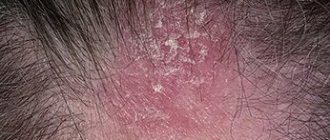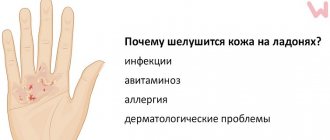Seborrheic alopecia is associated with dry, fine-plate peeling of the skin or increased secretion that occurs with seborrhea. Symptoms of the disease appear more often during the activity of sex hormones. The temporal and parietal regions are primarily affected. The affected areas are atrophic, thinned and can hardly be folded. The prognosis depends on the successful treatment of seborrheic alopecia. Most often, hair loss occurs due to increased secretion of the glands (or in other words, oily seborrhea).
Main features
The symptoms of seborrheic alopecia are similar to those of seborrhea, since both diseases are caused by a malfunction of the sebaceous glands. The main features include:
- unpleasant odor;
- rapid loss of freshness and cleanliness of hair after washing;
- thickened layer of keratinized skin;
- presence of inflammation.
Increased activity of the sebaceous glands leads to the appearance of excess oil on the skin. Sebaceous ducts and hair follicles become clogged. Horny particles accumulate on the scalp, face, and body. They stick together and form a viscous mass. This environment is good for fungal growth. The parasite becomes active, attacks the hair follicles, the hair becomes weak and begins to fall out.
There are three main types of seborrhea: dry, oily and mixed. Alopecia occurs with oily skin.
Message sent!
Thinning hair
The most common changes occur on the scalp, face, especially the forehead, eyebrows and turbinates.
Symptoms in children and adults are somewhat different. In adults and adolescents, the surface layers of the scalp break down into tiny yellow, oily scales. The skin underneath is red and some patients experience itching. The severity of these changes ranges from tiny, dandruff-like moist patches to severe erythema with multiple layers of scales. Erythema may expand its circumference and leave brown discoloration in previously discolored areas. Skin inflammation causes significant hair thinning and alopecia. But when the hair follicles are not damaged with appropriate treatment, the hair grows back slowly.
The disease can also occur on the skin of the chest, interscapular area, genital area and anus. In the groin, in the armpit, between the buttocks, they have a moist, juicy surface and are more intense.
Causes
Oily seborrhea can appear at any age. However, most often this occurs in adolescence and during hormonal imbalances in the body. Baldness is a consequence of chronic seborrhea, which can last for about five years without any serious consequences.
To begin adequate therapy, it is important to identify and eliminate the root cause of sebaceous gland dysfunction. It could be:
- failure of the endocrine system;
- disorders in the autonomic system;
- long-term drug treatment;
- hormonal disorder;
- hereditary predisposition;
- improper metabolism;
- poor nutrition;
- some diseases and complications of diseases.
Before starting treatment for baldness, it is important to conduct a medical examination to identify possible underlying causes.
How is hair loss related to sexual function?
Severe hair loss becomes obvious around the age of 35, although the process itself started much earlier. The spread of pathology affects small blood vessels in the upper layer of the epidermis, as well as the mouth of the follicle. As a result, their walls become thinner.
If women suffer from the disease, then hormonal imbalances will be observed in the body, but men may experience problems with sexual function.
If seborrheic alopecia is detected, appropriate treatment should be started immediately to avoid total hair loss.
Characteristic symptoms of seborrhea
Seborrheic dermatitis is characterized by a range of symptoms.
Bold form:
- frizzy, sticky hair;
- greasy shine;
- increased oiliness of facial skin;
- the appearance of redness, ulcers on the face, head and back;
- dandruff;
- seborrheic growths.
Dry form:
- tight, dry skin on which wounds easily form;
- dry hair;
- fragility, weakness of hairs;
- loose dandruff.
In both cases, itching may be present. The patient wants to scratch the skin all the time. Sometimes there is a feeling of soreness on the skin. With severe manifestations, wounds and ulcers that occur when scratching are possible.
Preventive measures
To prevent seborrhea, you need to follow several important rules:
- wash your hair regularly using shampoo and conditioner;
- adhere to proper nutrition and a healthy lifestyle;
- eliminate bad habits and reduce the amount of salty, sweet, island, fatty and fried foods in the diet;
- if you feel unwell, you should immediately consult a doctor, because any disease can cause alopecia;
- Dandruff should not be allowed to appear and at the first symptoms you should use antifungal drugs.
Nutrition, sports, timely treatment will increase the body’s protective functions and protect against the development of various pathologies, including seborrheic alopecia.
Complications of seborrhea
Alopecia does not begin to manifest itself immediately. First, redness and dandruff appear on the scalp. At the next stage, the nutrition of the hair follicles is disrupted. This is due to roughening of the skin and sebaceous layers. At the last stage, hair follicles begin to die, hair thinning is noticeable and its growth stops, and restoration becomes difficult.
With seborrhea, hair rarely falls out completely. However, the remnants of hair look very unpresentable. This appearance causes psychological disorders and makes it difficult to communicate with people.
Diagnostics
Alopecia can be diagnosed in several ways (the doctor determines it individually, depending on the client’s characteristics):
- Blood test for hormones to find out the levels of testosterone, estrogen and progesterone, which most affect seborrhea.
- An immunogram that determines the quality of the immune system.
- Blood test for HIV infection and syphilis. These diseases often manifest as baldness.
- Phototrichogram – study of hair condition.
Microscopic examination of the scalp can identify fungal organisms.
- A scalp biopsy (scrape of biomaterial for research) will determine the microflora and mycoses. These are dermatological diseases - fungi and lichen.
After these studies, the doctor makes a diagnosis and confirms or denies seborrheic alopecia.
Methods of therapy
With seborrheic dermatitis, hair can fall out both on the entire surface of the head and in certain areas (on the back of the head, temples, frontal part). It is better to prevent the problem from developing; it is very important to intervene at an early stage. The treatment is simple. However, the process is very lengthy and requires patience, an integrated approach and consistency. Work is being carried out in a number of areas:
- organization of proper nutrition;
- use of special hair care products;
- physiotherapy;
- drug treatment.
Types and forms
Seborrheic alopecia appears due to the strong secretion of oil from the sebaceous glands, which “put pressure” on the hair follicle and disrupt the phases of its development. As a result, the follicle dies and hair falls out. It can occur in three forms:
- Focal – hair falls out in some areas.
- Total alopecia - hair falls out evenly over the entire head, and if the pathology is not treated, the patient may become completely bald.
- Chaotic – hair falls out partially.
Fighting oily seborrhea
If the doctor has determined oily seborrhea, then in terms of nutrition you will need:
- exclude smoked meats and pickles, as well as cakes, sweets, cookies and other sweets;
- do not eat canned and pickled foods, as they provoke itching and deterioration of the skin;
- eat fresh vegetables and fruits;
- eat enough fiber, fish dishes, cereals, meat;
- refuse flour products;
- limit consumption of foods containing animal fat.
Cause of hair loss #2: systemic lupus erythematosus
Systemic lupus erythematosus is an autoimmune disease in which the body fights its own tissues. One of the clearest symptoms of lupus is thinning and increased hair loss.
lupus erythematosus
Lupus can be identified by other signs: hypersensitivity to sunlight and butterfly erythema on the face (redness of the cheeks and nose). Changes in the skin may take the form of hives and red discs. Common symptoms include pain and swelling in the joints, muscle pain and erosions in the mouth.
General principles of treatment
In complex cases of seborrheic dermatitis, doctors prescribe medications to improve digestion and improve metabolism. Therapy often also includes vitamins, minerals, and hormonal pills.
Depending on your medical history, your doctor may prescribe hair growth activators. For oily seborrhea, drying shampoos containing tar, sulfur or salicylic acid are used.
A specialist may prescribe the use of balms with moisturizing and nutritional components - amino acids, keratin, protein.
There are two main groups of care products that can stop hair loss due to seborrhea:
- stopping the formation of dandruff;
- stimulating hair growth.
The first includes antifungal shampoos, lotions, and scrubs. It is important to use them in accordance with the instructions. The second group includes herbal tinctures, masks, and oils for rubbing into the scalp. Their task is to strengthen hair and stimulate growth.
Diet therapy
In the treatment of alopecia, a balanced diet plays an important role. Food must contain the amount of minerals, vitamins, proteins, fats and complex carbohydrates necessary for the body. To prevent hair loss, your diet should contain foods containing the following substances:
- Vitamin C – normalizes the functioning of the sebaceous glands, dries the skin, and disinfects.
- Microelements are necessary for the renewal of hair cells. That is, the thickness and healthy shine of hair will depend on the amount of these substances.
- Antioxidants – neutralize the effects of free radicals and have a rejuvenating effect.
- Proteins, fats, carbohydrates help normalize the functioning of the entire body, thereby improving the structure of cells in the scalp and hair, and regenerating tissue at the cellular level.
- Iron is essential for beautiful hair and skin. It promotes the growth of red blood cells, in which the protein hemoglobin is formed, which is responsible for the transport of oxygen from the lungs to all organs. With its deficiency, the disease develops anemia, the symptom of which is hair loss.
You need to add a lot of water to your diet, drink at least 2 liters per day. nutritionists recommend this amount of water to everyone in order to improve the functioning of the gastrointestinal tract, increase the absorption of nutrients, and improve metabolism.
Healing oils
Oil therapy can be used for hair loss only after consultation with a specialist. Also, you should not choose masks for home preparation on your own if you are not sure that the composition will not harm hair weakened by seborrhea.
When treating alopecia, rose, flaxseed, lavender and castor oils may be recommended. They can be mixed with decoctions or herbal infusions and rubbed into the scalp. Lotions are made with oils and alcohol tinctures to help eliminate itching and redness.
In the presence of ulcers, oil wraps often help, as they restore metabolic processes in the scalp and hair follicles. Foci of inflammation, for example, are treated with oil solutions of vitamins A and E.
The most popular treatment regimens
If dandruff forms excessively, the problem cannot be ignored. Diagnosis and treatment can prevent widespread hair loss.
Seborrheic alopecia is treated with conservative methods. The complex includes:
- diet correction;
- external preparations;
- physiotherapeutic procedures;
- general therapy.
Nutrition correction
Treatment even with expensive drugs without following a diet may be ineffective. It is worth noting that the triggering factor for hair loss is “newfangled diets” for weight loss, which result in metabolic disorders. For hair loss, it is recommended to drink still water, freshly squeezed juices, and herbal decoctions. The diet includes lean varieties of meat and fish.
The diet must include vegetables high in fiber (pumpkin, zucchini, cabbage). It is useful to include asparagus and seaweed in your diet. Fruits and berries can be eaten in any quantity as long as they do not cause allergic reactions. It is recommended to replace butter with vegetable oil, eat porridge and focus on fermented milk products.
Eliminate quickly digestible carbohydrates from the diet, which provoke the growth of fungal flora. These include sugar, yeast products, starch. During treatment, it is prohibited to consume alcohol, fried, spicy and fatty foods, smoked foods, as well as foods that can cause allergies in the patient.
Local therapy
Seborrheic alopecia is effectively treated with topical medications that have anti-inflammatory and antifungal properties. Treatment includes shampoos with tar, salicylic acid or selenium sulfide. In advanced cases, hormonal drugs are prescribed. Ketoconazole, Terbinafine, Fluconazole effectively cope with the problem. It is useful to wash your hair with herbal decoctions that have anti-inflammatory properties (chamomile, calendula, nettle).
For dry seborrhea, ointments with salicylic acid, sulfur or hormones are prescribed, for oily seborrhea - alcohol products. Massage courses and physiotherapeutic procedures (mesotherapy, laser therapy, UHF, phonophoresis with zinc or magnesium, electrotrichogenesis) are effective. If you follow all the recommendations, you can get rid of the problem of hair loss in 3-6 months.
General treatment
General treatment consists of prescribing drugs that improve the functioning of the digestive system, mineral and vitamin complexes, and antihistamines. The regimen is selected strictly individually, taking into account the symptoms of the pathology. At the same time, concomitant diseases are treated, drugs are prescribed that restore the functioning of the autonomic and hormonal systems.
Hair replacement system
If treatment has not brought results, and the disease has led to extensive baldness, a method of restoring aesthetic appeal is recommended - a hair replacement system.
A partial hair cover is individually created for the patient, which is made taking into account the direction of growth, structure and color of the hair. For extensive baldness, a full cover is created. The resulting hair system is attached with reliable fasteners, which allow you to go to the pool, wash your hair, and do your hair.
Hair care during the treatment of seborrheic loss
Homemade masks and decoctions, selected together with a doctor, are a good help in the treatment of seborrheic hair loss. For example, you can use these tips:
- infusions and decoctions of oak bark and chamomile are suitable for disinfecting the skin;
- softening and nutrition - burdock root;
- drying - lemon water, soda water, a decoction of string;
- softening - a decoction of celandine or onion peels.
Warming masks have a beneficial effect. They stimulate blood circulation and accelerate hair growth. For such masks, take red pepper, onion, and mustard.
It is not recommended to wash your hair every day, as this can dry out your skin. If your hair quickly becomes oily at the roots, then you need to wash it 2-3 times a week, and dry hair once is enough.
Treatment of seborrheic alopecia at An-Tech Research Laboratories
In our trichology center you can undergo comprehensive treatment aimed at ridding women of alopecia. At your service:
- modern approach to treatment;
- application of effective treatment methods;
- accurate diagnostic methods;
- nice service and service.
Our specialists have been dealing with the treatment of any hair growth pathologies for many years, among which alopecia occupies one of the leading places.
Treatment is carried out using effective methods, using proven means. We are aimed at obtaining sustainable treatment results so that our patients will forget once and for all about such a common problem as alopecia. All treatment regimens are selected individually and taking into account the patient’s health characteristics. Back to list of articles
Cause of Hair Loss #3: Polycystic Ovarian Syndrome
One of the symptoms of polycystic ovary syndrome is androgenetic alopecia in women. This is male pattern baldness, which in women usually appears as diffuse thinning of the hair on the crown of the head.
In addition, during the course of the disease, significant weight gain (especially around the waist), scanty or irregular periods, acne on the chest, back, and excessive hair growth on the face, thighs, buttocks, and back appear.
Causes of seborrheic alopecia
There are several reasons leading to the development of seborrheic alopecia, among them:
- Hormonal changes in the body during puberty. This is the reason that determines the age at which the disease most often manifests. However, physiological seborrhea usually resolves on its own, in rare cases leading to alopecia;
- Violation of the ratio of estrogens and androgens. Androgens, when in excess, stimulate sebum production. Most often, women with seborrheic alopecia exhibit a lack of progesterone and estrogens and an increase in androgen levels in the blood;
- In men, an increase in androgen levels and acceleration of their metabolism also leads to baldness. Sometimes this pathological process is caused by a testicular tumor;
- Seborrheic alopecia can be caused by Parkinson's disease, encephalitis lethargica;
- Mental illnesses can provoke the development of the problem. For example, seborrheic alopecia is a common companion for people with schizophrenia, epilepsy, and psychosis;
- Taking certain medications can trigger the development of the disease. In this regard, long-term therapy with glucocorticosteroids, anabolic steroids, vitamin H, and hormonal drugs with testosterones and progesterones poses a danger;
- The pathological activity of yeast-like fungi, which are normally always present on the skin, can provoke the development of alopecia. At the same time, the fungi themselves are activated against the background of exacerbation of chronic infections, stress, and decreased immunity.









